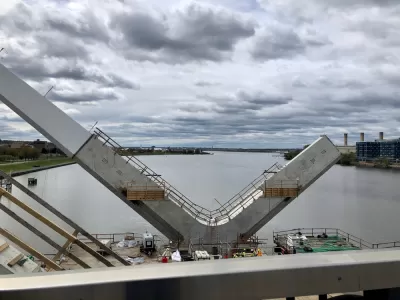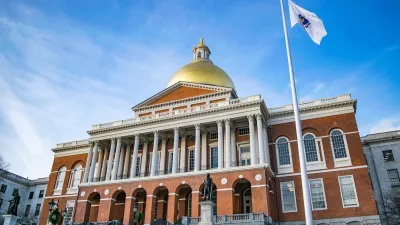The largest infrastructure project in D.C. history is opening this week—first to pedestrians and then to automobile traffic.

Luz Lazo and Michael Laris report on the debut of the new Frederick Douglass Memorial Bridge, which opened to the public on September 6 and replaced a 71-year-old bridge spanning the Anacostia River in Washington, D.C.
The new bridge is 1,445 feet long and cost $480 million—that latter figure making the new bridge the largest infrastructure project in the history of the District.
"The bridge is not finished. Vises hold up 2-by-4s as makeshift barriers on concrete lookout areas, and paving and connections aren’t complete on wide pedestrian pathways. But Monday’s bridge celebration — starting with a 5K run and walk led by Mayor Muriel E. Bowser — offered expansive views and the chance for many to consider a changing city," according to the article.
Vehicle traffic is expected to start crossing the bridge on Friday and Saturday of this week. "Runners, walkers and stroller-pushers began crossing the span about 9 a.m. Monday as an American flag waved from one of its towering white arches."
The article includes anecdotes and soundbites from the bridges debut on Labor Day. Lazo and Laris also sum up the relevance of the bridge's reopening relative to the larger cultural context and planning history of the District thusly:
The opening of the distinct structure with parallel arcs marks a milestone in the vision to turn the South Capitol Street Corridor into the grand boulevard that Pierre L’Enfant envisioned in his original plan for the nation’s capital. L’Enfant identified the corridor as a symbolic gateway into the District’s monumental core, one that has not been realized as the road maintained a freeway-type configuration that lacked adequate pedestrian and cycling facilities.
FULL STORY: New $480 million Frederick Douglass Memorial Bridge begins opening week with a Labor Day celebration

Study: Maui’s Plan to Convert Vacation Rentals to Long-Term Housing Could Cause Nearly $1 Billion Economic Loss
The plan would reduce visitor accommodation by 25,% resulting in 1,900 jobs lost.

North Texas Transit Leaders Tout Benefits of TOD for Growing Region
At a summit focused on transit-oriented development, policymakers discussed how North Texas’ expanded light rail system can serve as a tool for economic growth.

Using Old Oil and Gas Wells for Green Energy Storage
Penn State researchers have found that repurposing abandoned oil and gas wells for geothermal-assisted compressed-air energy storage can boost efficiency, reduce environmental risks, and support clean energy and job transitions.

Santa Barbara Could Build Housing on County Land
County supervisors moved forward a proposal to build workforce housing on two county-owned parcels.

San Mateo Formally Opposes Freeway Project
The city council will send a letter to Caltrans urging the agency to reconsider a plan to expand the 101 through the city of San Mateo.

A Bronx Community Fights to Have its Voice Heard
After organizing and giving input for decades, the community around the Kingsbridge Armory might actually see it redeveloped — and they want to continue to have a say in how it goes.
Urban Design for Planners 1: Software Tools
This six-course series explores essential urban design concepts using open source software and equips planners with the tools they need to participate fully in the urban design process.
Planning for Universal Design
Learn the tools for implementing Universal Design in planning regulations.
Ascent Environmental
Borough of Carlisle
Caltrans
Institute for Housing and Urban Development Studies (IHS)
City of Grandview
Harvard GSD Executive Education
Toledo-Lucas County Plan Commissions
Salt Lake City
NYU Wagner Graduate School of Public Service





























